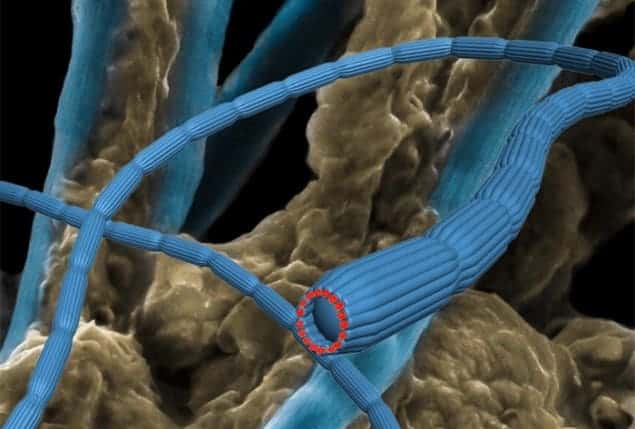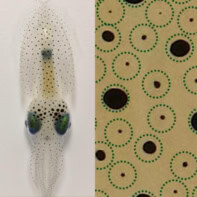
A newly discovered bacterium living on the bottom of the sea transports electrons over centimetre distances so it can feed on hydrogen sulphide in low-oxygen environments. That is the claim of scientists in Denmark and the US, who have shown that thousands of the micro-organisms form a filament with one end embedded in ocean sediments and the other end poking out into seawater. Understanding just how this organism moves electrons could lead to alternative technologies for generating energy.
Biologists have known for some time that the Desulfobulbaceae family of bacteria power themselves by consuming sulphur compounds in ocean sediments. However, this produces hydrogen sulphide, which is toxic at high concentrations. While these bacteria can consume hydrogen sulphide, this must be done in the presence of oxygen in a reaction that involves the transfer of an electron.
Ocean sediments normally have very low oxygen levels and studies have shown that when Desulfobulbaceae are present, sulphide levels increase steadily. But then something unexpected happens – sulphide levels drop quickly as if the sediments have experienced a rapid influx of oxygen. The problem is that the drop is so fast that it cannot be explained by the diffusion of oxygen molecules from the seawater above. Instead, scientists had thought that the many different species of Desulfobulbaceae bacteria in the sediment were somehow working together to move electrons from oxygen-poor regions up to the seawater, where oxygen is plentiful.
Lone bacterium
Now a team that includes the physicist Mohamed El-Naggar and colleagues at the University of Southern California and Aarhus University have taken a closer look at the bacteria in the sediments and have made a startling discovery – the electron transport appears to be done by just one type of bacterium, which creates centimetre-long filaments that are made up of thousands of micro-organisms joined together end-to-end.
What is more, tests on the tiny filaments suggest that the electrons are conducted along special string-like structures within the bacteria.
The electrical properties of the filaments were first studied by doing “source–drain” measurements. The filamentous bacteria were deposited on an insulating surface of silicon oxide that also contained gold electrodes. The team focused on those filaments that happened to bridge two electrodes, which allowed them to apply a voltage along the filament and measure the electron current. But when voltages as high as 10 V were applied along the filaments, no measureable current was found. This led the team to conclude that the bacteria were not acting like bare conducting wires, but rather that the conduction process takes place inside an insulating sheath – much like an electrical cable.
Very high capacitance
To try to work out which internal parts of the bacteria are involved in electron transport, El-Naggar and colleagues used a technique called electrostatic force microscopy (EFM). This involves placing an extremely small electrode very near to the surface of a bacterium and measuring how the capacitance changes as the electrode is oscillated up and down. By scanning the tip over the surface, the team found that string-like structures just under the bacterium’s outer membrane have a very high capacity for storing charge. “This is very suggestive for their role in carrying charge, and will be the focus of future studies, El-Naggar told physicsworld.com.
The process by which the conduction occurs is still a mystery: “There are two points of view on the subject that stem from two completely different physical limits”. One school of thought is that conduction is similar to “band conduction” seen in metals and semiconductors – however, El-Naggar points out that the observed electron mobility is too low to support this idea. Instead, he favours a hopping model whereby charge jumps along the bacterium from one position to the next. “This is an incoherent process that takes place in multiple steps, somewhat like a bucket brigade.”
Beyond shining a light on ecosystems at the bottom of the sea, El-Naggar believes that gaining a better understanding of how this conduction occurs could lead to practical applications. “I think it is likely that long-range bacterial electron transfer will open the door to new environmental clean up and renewable energy technologies, by coupling these living processes to non-living electrodes,” he says.
The study is described in Nature.



